Flume(4)-监控模型
一. 监控端口数据
首先启动Flume任务,监控本机44444端口,服务端;
然后通过netcat工具向本机44444端口发送消息,客户端;
最后Flume将监听的数据实时显示在控制台。
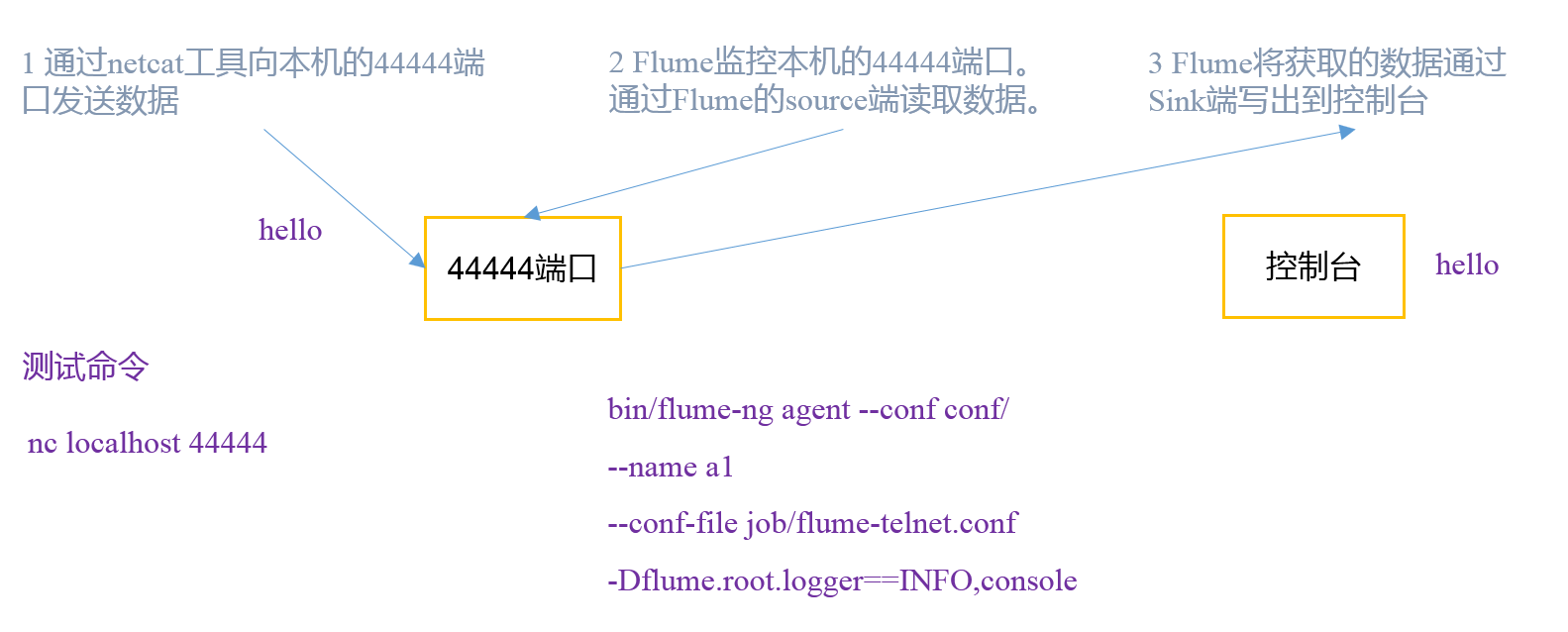
1. 安装netcat
sudo yum install -y nc
功能描述:netstat命令是一个监控TCP/IP网络的非常有用的工具,它可以显示路由表、实际的网络连接以及每一个网络接口设备的状态信息。
基本语法:netstat [选项]
选项参数:
-t或--tcp:显示TCP传输协议的连线状况;
-u或--udp:显示UDP传输协议的连线状况;
-n或--numeric:直接使用ip地址,而不通过域名服务器;
-l或--listening:显示监控中的服务器的Socket;
-p或--programs:显示正在使用Socket的程序识别码(PID)和程序名称;
2. 判断端口是否被占用
sudo netstat -tunlp | grep
3. 创建Flume Agent配置文件flume-netcat-logger.conf
#在flume目录下创建job文件夹并进入job文件夹。
mkdir job
cd job/ #在job文件夹下创建Flume Agent配置文件flume-netcat-logger.conf
touch flume-netcat-logger.conf
在flume-netcat-logger.conf文件中添加如下内容。
# Name the components on this agent
#a1表示agent的名称
a1.sources = r1 #r1表示a1的输入源source
a1.sinks = k1 #k1表示a1的输出目的地sink
a1.channels = c1 #c1表示a1的缓冲区channel # Describe/configure the source
a1.sources.r1.type = netcat #表示a1的输入源为netcat端口类型
a1.sources.r1.bind = localhost #表示a1监听的主机地址
a1.sources.r1.port = 44444 #表示a1监听的端口 # Describe the sink
a1.sinks.k1.type = logger #表示a1的输出目的地是控制台的logger类型 # Use a channel which buffers events in memory
a1.channels.c1.type = memory #表示a1的channel类型为memory类型
a1.channels.c1.capacity = 1000 #表示a1的channel总容量是1000个event
a1.channels.c1.transactionCapacity = 100 #表示a1的channel传输时收集到100条event后再去提交事务 # Bind the source and sink to the channel
a1.sources.r1.channels = c1 #表示将r1和c1连接起来
a1.sinks.k1.channel = c1 #表示将k1和c1连接起来
其他参数或参数详解,请参阅官方手册http://flume.apache.org/FlumeUserGuide.html
4. 开启Flume监听端口
#第一种写法:
bin/flume-ng agent --conf conf/ --name a1 --conf-file job/flume-netcat-logger.conf -Dflume.root.logger=INFO,console #第二种写法:
bin/flume-ng agent -c conf/ -n a1 –f job/flume-netcat-logger.conf -Dflume.root.logger=INFO,console
开启后会阻塞
参数说明:
--conf conf/ :表示配置文件存储在conf/目录
--name a1 :表示给agent起名为a1
--conf-file job/flume-netcat.conf :flume本次启动读取的配置文件是在job文件夹下的flume-telnet.conf文件。
-Dflume.root.logger==INFO,console :-D表示flume运行时动态修改flume.root.logger参数属性值,并将控制台日志打印级别设置为INFO级别。日志级别包括:log、info、warn、error。
5. 使用netcat工具向本机的44444端口发送内容

6. 在Flume监听页查看接收数据

二. 实时读取本地文件到HDFS
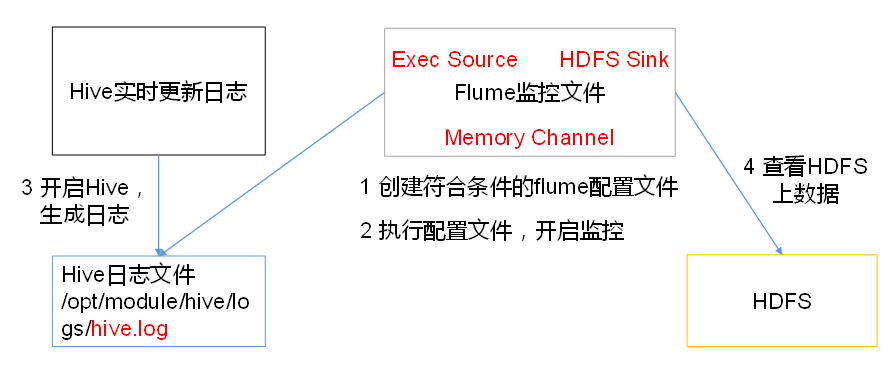
1. 让Flume持有Hadoop相关jar包
将commons-configuration-1.6.jar、
hadoop-auth-2.7.2.jar、
hadoop-common-2.7.2.jar、
hadoop-hdfs-2.7.2.jar、
commons-io-2.4.jar、
htrace-core-3.1.0-incubating.jar
拷贝到/opt/module/flume/lib文件夹下(如果已经持有的话,略过)。
2. 创建flume-file-hdfs.conf文件
#在hob目录下创建文件
touch flume-file-hdfs.conf
要想读取Linux系统中的文件,就得按照Linux命令的规则执行命令。由于Hive日志在Linux系统中所以读取文件的类型选择:exec即execute执行的意思。表示执行Linux命令来读取文件
在flume-file-hdfs.conf中添加如下内容
# Name the components on this agent
a2.sources = r2
a2.sinks = k2
a2.channels = c2 # Describe/configure the source
a2.sources.r2.type = exec #定义source类型为exec可执行文件
a2.sources.r2.command = tail -F /opt/module/hive/logs/hive.log #要执行的linux命令
a2.sources.r2.shell = /bin/bash -c #执行shell脚本的绝对路径 # Describe the sink
a2.sinks.k2.type = hdfs #sink类型为hdfs
a2.sinks.k2.hdfs.path = hdfs://hadoop100:9000/flume/%Y%m%d/%H #上传文件再hdfs上的路径 转义序列的详解见下表
#上传文件的前缀
a2.sinks.k2.hdfs.filePrefix = logs-
#是否按照时间滚动文件夹
a2.sinks.k2.hdfs.round = true
#多少时间单位创建一个新的文件夹
a2.sinks.k2.hdfs.roundValue =
#重新定义时间单位
a2.sinks.k2.hdfs.roundUnit = hour
#是否使用本地时间戳
a2.sinks.k2.hdfs.useLocalTimeStamp = true
#积攒多少个Event才flush到HDFS一次
a2.sinks.k2.hdfs.batchSize =
#设置文件类型,可支持压缩
a2.sinks.k2.hdfs.fileType = DataStream
#多久生成一个新的文件
a2.sinks.k2.hdfs.rollInterval =
#设置每个文件的滚动大小
a2.sinks.k2.hdfs.rollSize =
#文件的滚动与Event数量无关
a2.sinks.k2.hdfs.rollCount = # Use a channel which buffers events in memory
a2.channels.c2.type = memory
a2.channels.c2.capacity =
a2.channels.c2.transactionCapacity = # Bind the source and sink to the channel
a2.sources.r2.channels = c2
a2.sinks.k2.channel = c2
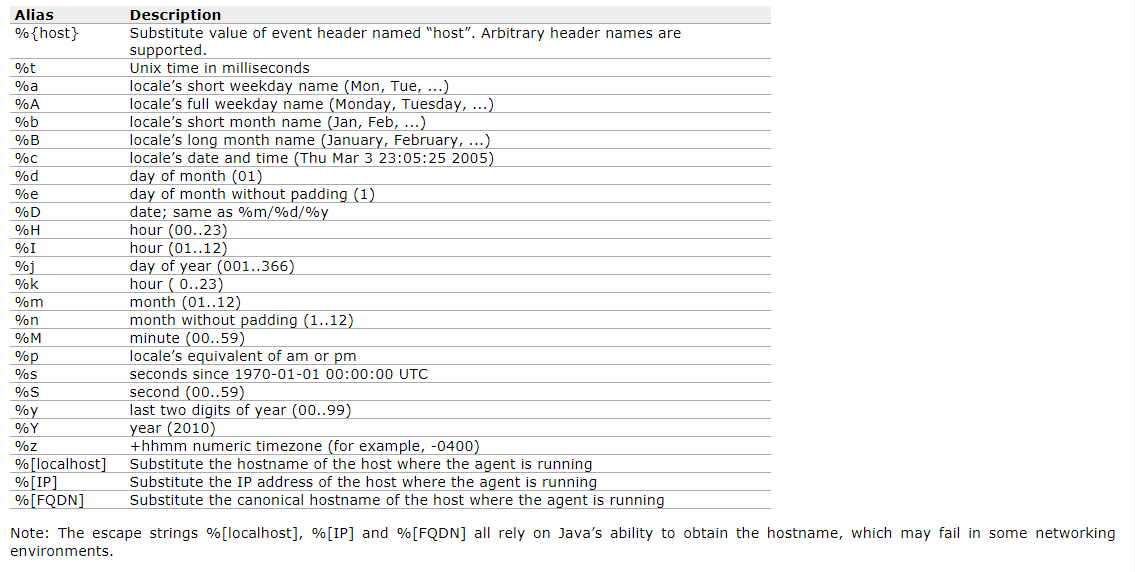
注意 : 对于所有与时间相关的转义序列,Event Header中必须存在以 “timestamp”的key(除非hdfs.useLocalTimeStamp设置为true,此方法会使用TimestampInterceptor自动添加timestamp)。
3. 开启Flume监控
bin/flume-ng agent --conf conf/ --name a2 --conf-file job/flume-file-hdfs.conf
4. 开启hdfs和hive,操作hive产生日志
#开启hdfs
sbin/start-dfs.sh #开启hive产生日志
bin/hive
5. 在HDFS上查看文件

三. 实时读取目录文件到HDFS

1. 创建配置文件flume-dir-hdfs.conf
#再job目录下创建文件
touch flume-dir-hdfs.conf
添加以下内容
a3.sources = r3
a3.sinks = k3
a3.channels = c3 # Describe/configure the source
#source类型为spooldir
a3.sources.r3.type = spooldir
#监控的目录
a3.sources.r3.spoolDir = /opt/module/flume/upload
#文件上传完后的文件后缀
a3.sources.r3.fileSuffix = .COMPLETED
#是否有文件头
a3.sources.r3.fileHeader = true
#忽略所有以.tmp结尾的文件,不上传
a3.sources.r3.ignorePattern = ([^ ]*\.tmp) # Describe the sink
a3.sinks.k3.type = hdfs
a3.sinks.k3.hdfs.path = hdfs://hadoop100:9000/flume/upload/%Y%m%d/%H
#上传文件的前缀
a3.sinks.k3.hdfs.filePrefix = upload-
#是否按照时间滚动文件夹
a3.sinks.k3.hdfs.round = true
#多少时间单位创建一个新的文件夹
a3.sinks.k3.hdfs.roundValue =
#重新定义时间单位
a3.sinks.k3.hdfs.roundUnit = hour
#是否使用本地时间戳
a3.sinks.k3.hdfs.useLocalTimeStamp = true
#积攒多少个Event才flush到HDFS一次
a3.sinks.k3.hdfs.batchSize =
#设置文件类型,可支持压缩
a3.sinks.k3.hdfs.fileType = DataStream
#多久生成一个新的文件
a3.sinks.k3.hdfs.rollInterval =
#设置每个文件的滚动大小大概是128M
a3.sinks.k3.hdfs.rollSize =
#文件的滚动与Event数量无关
a3.sinks.k3.hdfs.rollCount = # Use a channel which buffers events in memory
a3.channels.c3.type = memory
a3.channels.c3.capacity =
a3.channels.c3.transactionCapacity = # Bind the source and sink to the channel
a3.sources.r3.channels = c3
a3.sinks.k3.channel = c3
2. 启动监控
bin/flume-ng agent --conf conf/ --name a3 --conf-file job/flume-dir-hdfs.conf
说明: 在使用Spooling Directory Source时,不要在监控目录中创建并持续修改文件;上传完成的文件会以.COMPLETED结尾;被监控文件夹每500毫秒扫描一次文件变动
3. 向upload文件夹中添加文件

4. 查看HDFS

5. 查看upload文件夹

四. 单数据源多出口(选择器)
使用Flume-1监控文件变动,Flume-1将变动内容传递给Flume-2,Flume-2负责存储到HDFS。
同时Flume-1将变动内容传递给Flume-3,Flume-3负责输出到Local FileSystem。
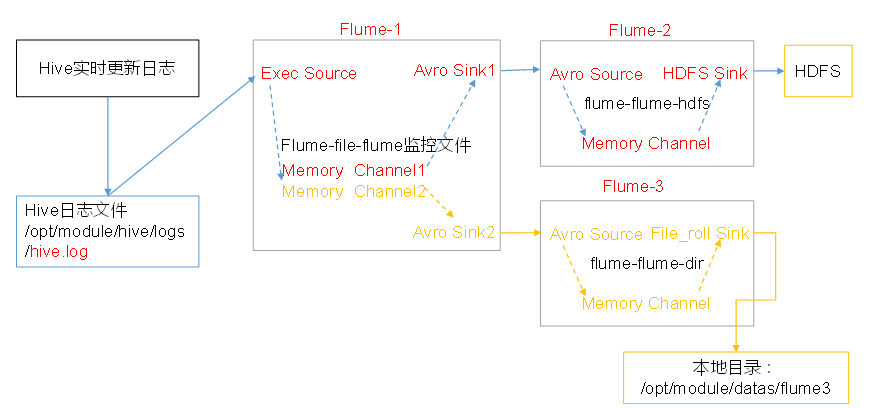
1. 准备工作
#在/opt/module/flume/job目录下创建group1文件夹
mkdir group1 #在/opt/module/datas/目录下创建flume3文件夹
mkdir flume3
2.创建flume-file-flume.conf
配置1个接收日志文件的source和两个channel、两个sink,分别输送给flume-flume-hdfs和flume-flume-dir。
进入group1文件夹,创建flume-file-flume.conf,添加如下内容
# Name the components on this agent
a1.sources = r1
a1.sinks = k1 k2
a1.channels = c1 c2
# 将数据流复制给所有channel
a1.sources.r1.selector.type = replicating # Describe/configure the source
a1.sources.r1.type = exec
a1.sources.r1.command = tail -F /opt/module/hive-1.2.1/logs/hive.log
a1.sources.r1.shell = /bin/bash -c # Describe the sink
# sink端的avro是一个数据发送者
a1.sinks.k1.type = avro
a1.sinks.k1.hostname = hadoop100
a1.sinks.k1.port = a1.sinks.k2.type = avro
a1.sinks.k2.hostname = hadoop100
a1.sinks.k2.port = # Describe the channel
a1.channels.c1.type = memory
a1.channels.c1.capacity =
a1.channels.c1.transactionCapacity = a1.channels.c2.type = memory
a1.channels.c2.capacity =
a1.channels.c2.transactionCapacity = # Bind the source and sink to the channel
a1.sources.r1.channels = c1 c2
a1.sinks.k1.channel = c1
a1.sinks.k2.channel = c2
3. 创建flume-flume-hdfs.conf
配置上级Flume输出的Source,输出是到HDFS的Sink.在group1目录下创建flume-flume-hdfs.conf,添加以下内容
# Name the components on this agent
a2.sources = r1
a2.sinks = k1
a2.channels = c1
# Describe/configure the source
# source端的avro是一个数据接收服务
a2.sources.r1.type = avro
a2.sources.r1.bind = hadoop100
a2.sources.r1.port = # Describe the sink
a2.sinks.k1.type = hdfs
a2.sinks.k1.hdfs.path = hdfs://hadoop100:9000/flume2/%Y%m%d/%H
#上传文件的前缀
a2.sinks.k1.hdfs.filePrefix = flume2-
#是否按照时间滚动文件夹
a2.sinks.k1.hdfs.round = true
#多少时间单位创建一个新的文件夹
a2.sinks.k1.hdfs.roundValue =
#重新定义时间单位
a2.sinks.k1.hdfs.roundUnit = hour
#是否使用本地时间戳
a2.sinks.k1.hdfs.useLocalTimeStamp = true
#积攒多少个Event才flush到HDFS一次
a2.sinks.k1.hdfs.batchSize =
#设置文件类型,可支持压缩
a2.sinks.k1.hdfs.fileType = DataStream
#多久生成一个新的文件
a2.sinks.k1.hdfs.rollInterval =
#设置每个文件的滚动大小大概是128M
a2.sinks.k1.hdfs.rollSize =
#文件的滚动与Event数量无关
a2.sinks.k1.hdfs.rollCount = # Describe the channel
a2.channels.c1.type = memory
a2.channels.c1.capacity =
a2.channels.c1.transactionCapacity = # Bind the source and sink to the channel
a2.sources.r1.channels = c1
a2.sinks.k1.channel = c1
4. 创建flume-flume-dir.conf
配置上级Flume输出的Source,输出是到本地目录的Sink。在group1目录下,创建flume-flume-dir.conf,添加以下内容
# Name the components on this agent
a3.sources = r1
a3.sinks = k1
a3.channels = c2 # Describe/configure the source
a3.sources.r1.type = avro
a3.sources.r1.bind = hadoop100
a3.sources.r1.port = # Describe the sink
a3.sinks.k1.type = file_roll
a3.sinks.k1.sink.directory = /opt/module/datas/flume3 # Describe the channel
a3.channels.c2.type = memory
a3.channels.c2.capacity =
a3.channels.c2.transactionCapacity = # Bind the source and sink to the channel
a3.sources.r1.channels = c2
a3.sinks.k1.channel = c2
注: 输出的本地目录必须是已经存在的目录,如果该目录不存在,并不会创建新的目录。
5. 执行配置文件
分别开启对应配置文件:flume-flume-dir,flume-flume-hdfs,flume-file-flume。
bin/flume-ng agent --conf conf/ --name a3 --conf-file jobs/group1/flume-flume-dir.conf bin/flume-ng agent --conf conf/ --name a2 --conf-file jobs/group1/flume-flume-hdfs.conf bin/flume-ng agent --conf conf/ --name a1 --conf-file jobs/group1/flume-file-flume.conf
6. 启动Hadoop和Hive
#启动hdfs
start-dfs.sh #进入到hive目录下,启动hive
bin/hive
7. 检查HDFS上数据和/opt/module/datas/flume3目录中数据

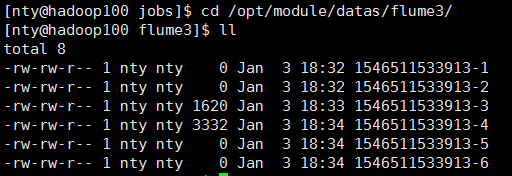
为什么会有6个文件?

file_roll的默认配置是每30秒滚动一次文件.只要没有停止监控,隔30秒去ll一下,就会看到文件又多了
五. 单数据源多出口(Sink组)
使用Flume-1监控文件变动,Flume-1将变动内容传递给Flume-2,Flume-2负责存储到HDFS。同时Flume-1将变动内容传递给Flume-3,Flume-3也负责存储到HDFS
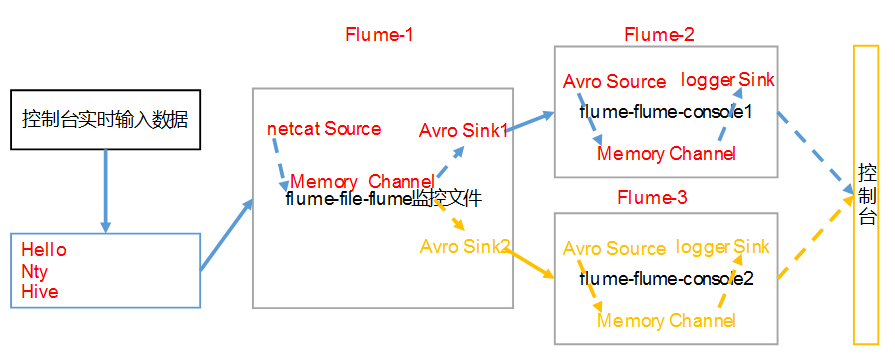
1. 准备工作
#在/opt/module/flume/jobs目录下创建group2文件夹
mkdir group2
2. 创建flume-netcat-flume.conf
配置1个接收日志文件的source和1个channel、两个sink,分别输送给flume-flume-console1和flume-flume-console2。
进入group2文件夹,创建flume-netcat-flume.conf,添加以下内容
# Name the components on this agent
a1.sources = r1
a1.channels = c1
a1.sinkgroups = g1
a1.sinks = k1 k2 # Describe/configure the source
a1.sources.r1.type = netcat
a1.sources.r1.bind = localhost
a1.sources.r1.port = #The component type name, needs to be default, failover or load_balance
a1.sinkgroups.g1.processor.type = load_balance
a1.sinkgroups.g1.processor.backoff = true
# Must be either round_robin, random or FQCN of custom class that inherits from AbstractSinkSelector
a1.sinkgroups.g1.processor.selector = round_robin
a1.sinkgroups.g1.processor.selector.maxTimeOut= # Describe the sink
a1.sinks.k1.type = avro
a1.sinks.k1.hostname = hadoop100
a1.sinks.k1.port = a1.sinks.k2.type = avro
a1.sinks.k2.hostname = hadoop100
a1.sinks.k2.port = # Describe the channel
a1.channels.c1.type = memory
a1.channels.c1.capacity =
a1.channels.c1.transactionCapacity = # Bind the source and sink to the channel
a1.sources.r1.channels = c1
a1.sinkgroups.g1.sinks = k1 k2
a1.sinks.k1.channel = c1
a1.sinks.k2.channel = c1
3. 创建flume-flume-console1.conf
配置上级Flume输出的Source,输出是到本地控制台。
在group2目录下,创建flume-flume-console1.conf,添加以下内容
# Name the components on this agent
a2.sources = r1
a2.sinks = k1
a2.channels = c1 # Describe/configure the source
a2.sources.r1.type = avro
a2.sources.r1.bind = hadoop100
a2.sources.r1.port = # Describe the sink
a2.sinks.k1.type = logger # Describe the channel
a2.channels.c1.type = memory
a2.channels.c1.capacity =
a2.channels.c1.transactionCapacity = # Bind the source and sink to the channel
a2.sources.r1.channels = c1
a2.sinks.k1.channel = c1
4. 创建flume-flume-console2.conf
配置上级Flume输出的Source,输出是到本地控制台。
在group2目录下.创建flume-flume-console2.conf,添加以下内容
# Name the components on this agent
a3.sources = r1
a3.sinks = k1
a3.channels = c2 # Describe/configure the source
a3.sources.r1.type = avro
a3.sources.r1.bind = hadoop100
a3.sources.r1.port = # Describe the sink
a3.sinks.k1.type = logger # Describe the channel
a3.channels.c2.type = memory
a3.channels.c2.capacity =
a3.channels.c2.transactionCapacity = # Bind the source and sink to the channel
a3.sources.r1.channels = c2
a3.sinks.k1.channel = c2
5. 执行配置文件
分别开启对应配置文件:flume-flume-console2,flume-flume-console1,flume-netcat-flume。
bin/flume-ng agent --conf conf/ --name a3 --conf-file jobs/group2/flume-flume-console2.conf -Dflume.root.logger=INFO,console bin/flume-ng agent --conf conf/ --name a2 --conf-file jobs/group2/flume-flume-console1.conf -Dflume.root.logger=INFO,console bin/flume-ng agent --conf conf/ --name a1 --conf-file jobs/group2/flume-netcat-flume.conf
6. 使用netcat工具向本机的44444端口发送内容
nc localhost
7. 查看Flume2及Flume3的控制台打印日志
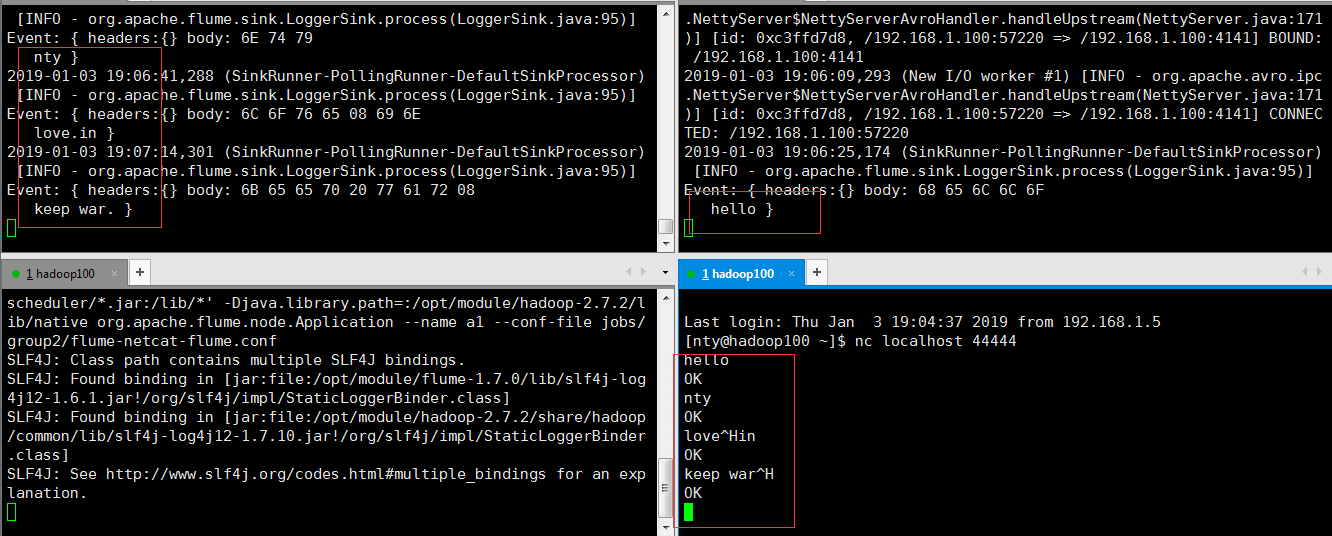
六. 多数据源汇总(常用)
hadoop101上的Flume-1监控文件/opt/module/group.log,
hadoop100上的Flume-2监控某一个端口的数据流,
Flume-1与Flume-2将数据发送给hadoop102上的Flume-3,Flume-3将最终数据打印到控制台

1. 准备工作
如果hadoop101和hadoop102没有安装flume,用分发脚本将flume分发一下
xsync flume-1.7./
在hadoop100、hadoop101以及hadoop102的/opt/module/flume/jobs目录下创建一个group3文件夹。
2. 创建flume1-logger-flume.conf
配置Source用于监控hive.log文件,配置Sink输出数据到下一级Flume。
在hadoop101上创建配置文件flume1-logger-flume.conf,并添加以下内容
# Name the components on this agent
a1.sources = r1
a1.sinks = k1
a1.channels = c1 # Describe/configure the source
a1.sources.r1.type = exec
a1.sources.r1.command = tail -F /opt/module/group.log
a1.sources.r1.shell = /bin/bash -c # Describe the sink
a1.sinks.k1.type = avro
a1.sinks.k1.hostname = hadoop102
a1.sinks.k1.port = # Describe the channel
a1.channels.c1.type = memory
a1.channels.c1.capacity =
a1.channels.c1.transactionCapacity = # Bind the source and sink to the channel
a1.sources.r1.channels = c1
a1.sinks.k1.channel = c1
3. 创建创建flume2-netcat-flume.conf
配置Source监控端口44444数据流,配置Sink数据到下一级Flume:
在hadoop100上创建配置文件flume2-netcat-flume.conf,并添加以下内容
# Name the components on this agent
a2.sources = r1
a2.sinks = k1
a2.channels = c1 # Describe/configure the source
a2.sources.r1.type = netcat
a2.sources.r1.bind = hadoop100
a2.sources.r1.port = # Describe the sink
a2.sinks.k1.type = avro
a2.sinks.k1.hostname = hadoop102
a2.sinks.k1.port = # Use a channel which buffers events in memory
a2.channels.c1.type = memory
a2.channels.c1.capacity =
a2.channels.c1.transactionCapacity = # Bind the source and sink to the channel
a2.sources.r1.channels = c1
a2.sinks.k1.channel = c1
4. 创建flume3-flume-logger.conf
配置source用于接收flume1与flume2发送过来的数据流,最终合并后sink到控制台。
在hadoop102上创建配置文件flume3-flume-logger.conf,并添加以下内容
# Name the components on this agent
a3.sources = r1
a3.sinks = k1
a3.channels = c1 # Describe/configure the source
a3.sources.r1.type = avro
a3.sources.r1.bind = hadoop102
a3.sources.r1.port = # Describe the sink
# Describe the sink
a3.sinks.k1.type = logger # Describe the channel
a3.channels.c1.type = memory
a3.channels.c1.capacity =
a3.channels.c1.transactionCapacity = # Bind the source and sink to the channel
a3.sources.r1.channels = c1
a3.sinks.k1.channel = c1
5. 执行配置文件
分别开启对应配置文件:flume3-flume-logger.conf,flume2-netcat-flume.conf,flume1-logger-flume.conf。
#hadoop102
bin/flume-ng agent --conf conf/ --name a3 --conf-file jobs/group3/flume3-flume-logger.conf -Dflume.root.logger=INFO,console #hadoop100
bin/flume-ng agent --conf conf/ --name a2 --conf-file jobs/group3/flume2-netcat-flume.conf #hadoop101
bin/flume-ng agent --conf conf/ --name a1 --conf-file jobs/group3/flume1-logger-flume.conf
6. 在hadoop101上向/opt/module目录下的group.log追加内容

7. 在hadoop100上向44444端口发送数据

8. 观察hadoop102上的数据

Flume(4)-监控模型的更多相关文章
- 使用WebGL 自定义 3D 摄像头监控模型
前言 随着视频监控联网系统的不断普及和发展, 网络摄像机更多的应用于监控系统中,尤其是高清时代的来临,更加快了网络摄像机的发展和应用. 在监控摄像机数量的不断庞大的同时,在监控系统中面临着严峻的现状问 ...
- 基于 HTML5 的 WebGL 自定义 3D 摄像头监控模型
前言 随着视频监控联网系统的不断普及和发展, 网络摄像机更多的应用于监控系统中,尤其是高清时代的来临,更加快了网络摄像机的发展和应用. 在监控摄像机数量的不断庞大的同时,在监控系统中面临着严峻的现状问 ...
- Flume实时监控目录sink到hdfs,再用sparkStreaming监控hdfs的这个目录,对数据进行计算
目标:Flume实时监控目录sink到hdfs,再用sparkStreaming监控hdfs的这个目录,对数据进行计算 1.flume的配置,配置spoolDirSource_hdfsSink.pro ...
- Flume的监控参数
参考 flume的http监控参数说明 普通的flume启动命令 bin/flume-ng agent -c conf -f conf/flume-conf.properties -n agent - ...
- 第1节 flume:7、flume的监控文件夹,实现数据收集到hdfs上
1.2.2 采集案例 1.采集目录到HDFS 需求分析 结构示意图: 采集需求:某服务器的某特定目录下,会不断产生新的文件,每当有新文件出现,就需要把文件采集到HDFS中去 根据需求,首先定义以下3大 ...
- Flume 知识点(六)Flume 的监控
简述 使用 Flume 实时收集日志的过程中,尽管有事务机制保证数据不丢失,但仍然需要时刻关注 Source.Channel.Sink 之间的消息传输是否正常. 比如,SouceChannel 传输了 ...
- Flume 概念、模型和特点
Flume Event - Flume 事件 - 被定义为一个具有有效荷载的字节数据流和可选的字符串属性集. Flume Agent- Flume - 代理 - 是一个进程承载从外部源事件流到下一个目 ...
- flume监控之ganglia
对于日志来说,我觉得监控意义不大,因为写的速度一般不会特别快,但是如果是spooldir source,里面一小时放入十几G的数据让flume解析,特别是在结合kafka或者其他框架的话,监控就显得重 ...
- open-falcon监控Flume
1.首先你需要知道flume的http监控端口是否启动 请参考博文 Flume的监控参数 即在 http://localhost:3000/metrics 可以访问到如下内容 2.在open-falc ...
随机推荐
- Attempt to load Oracle client libraries threw BadImageFormatException. This problem will occur when running in 64 bit mode with the 32 bit Oracle client components installed.
System.Data.OracleClient 已经过时了.微软不再支持它. 因此,我建议你为. NET 使用Oracle数据提供程序:ODP.Net. 你可以从以下位置下载: 版本:Release ...
- js获取鼠标坐标位置兼容多个浏览器
这个是IE 11 下兼容下视图测试时可用. $(window).bind('beforeunload', function (event) { var _this = this; var x = ev ...
- Microsoft Visual Studio 遇到了问题需要关闭
新年刚来Microsoft Visual Studio就找麻烦,debug的时候如果不打断点可以正常跑过,一打断点就崩溃,重启.报的问题是:Microsoft Visual Studio 遇到了问题需 ...
- Production-Ready Beanstalkd with Laravel 4 Queues
原文地址:http://fideloper.com/ubuntu-beanstalkd-and-laravel4 Note: TL;DR version at the bottom! Queues a ...
- 记录c++本地文件读取组装
class ErrorCodeConfig{ public: ErrorCodeConfig(){} ErrorCodeConfig(const ErrorCodeConfig&)=delet ...
- Java虚拟机8:垃圾收集(GC)-3(垃圾收集算法)
1.垃圾对象的判断 Java堆中存放着几乎所有的对象实例,垃圾收集器对堆中的对象进行回收前,要先确定这些对象是否还有用,判定对象是否为垃圾对象有如下算法: (1):引用计数算法 给对象添加一个引用计数 ...
- c++ 派生类的复制函数次序,及子父类兼容性
#include <iostream> using namespace std; class CFatherSum //父类Sum { public: CFatherSum(){cout& ...
- webview综述
nWebView 是webkit最核心的一个view,WebView管理WebFrameView和WebFrame之间的交互,一个WebView对象绑定一个window,并且要求MainFrame加载 ...
- vim 取消高亮
/ 匹配以后会一直有高亮,退出以后还是有: set nohlsearch nohlsearch
- 【JavaScript】explode动画
这是一个js实现的粒子聚合文字或图片的动画特效 部分程序如下 n.container = n.container[0] || n.container; /*有且仅有一个container*/ var ...
